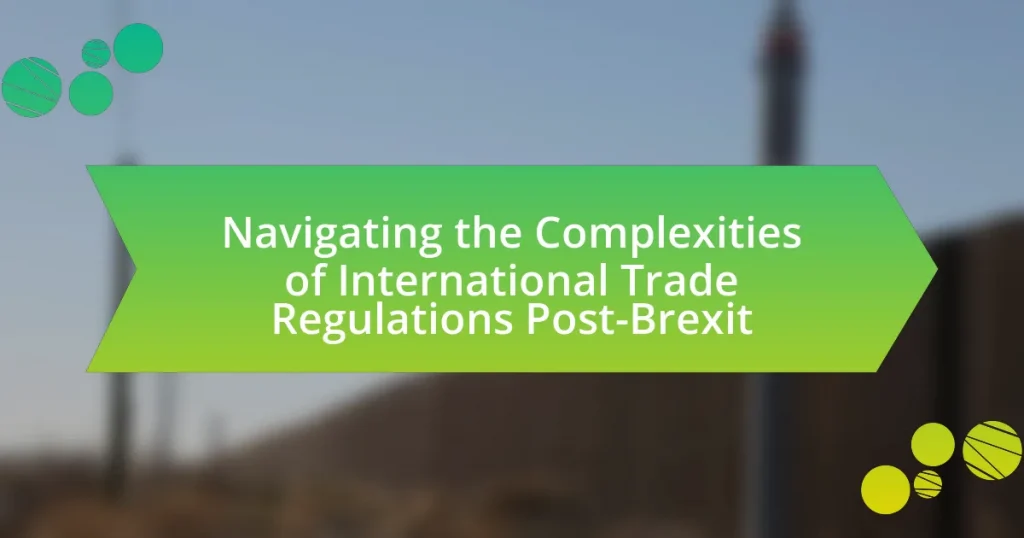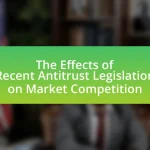The article focuses on the complexities of international trade regulations following Brexit, highlighting the significant changes in customs checks, tariff schedules, and compliance requirements for businesses operating between the UK and EU. It outlines how the UK’s departure from the EU Single Market has introduced new administrative burdens, necessitating a thorough understanding of evolving regulations to avoid penalties and ensure smooth trade operations. Key challenges include increased customs checks, regulatory divergence, and the impact of non-tariff barriers, which complicate compliance and affect supply chains. The article emphasizes the importance of staying informed about regulatory changes and adopting effective compliance strategies to navigate the post-Brexit trade landscape successfully.
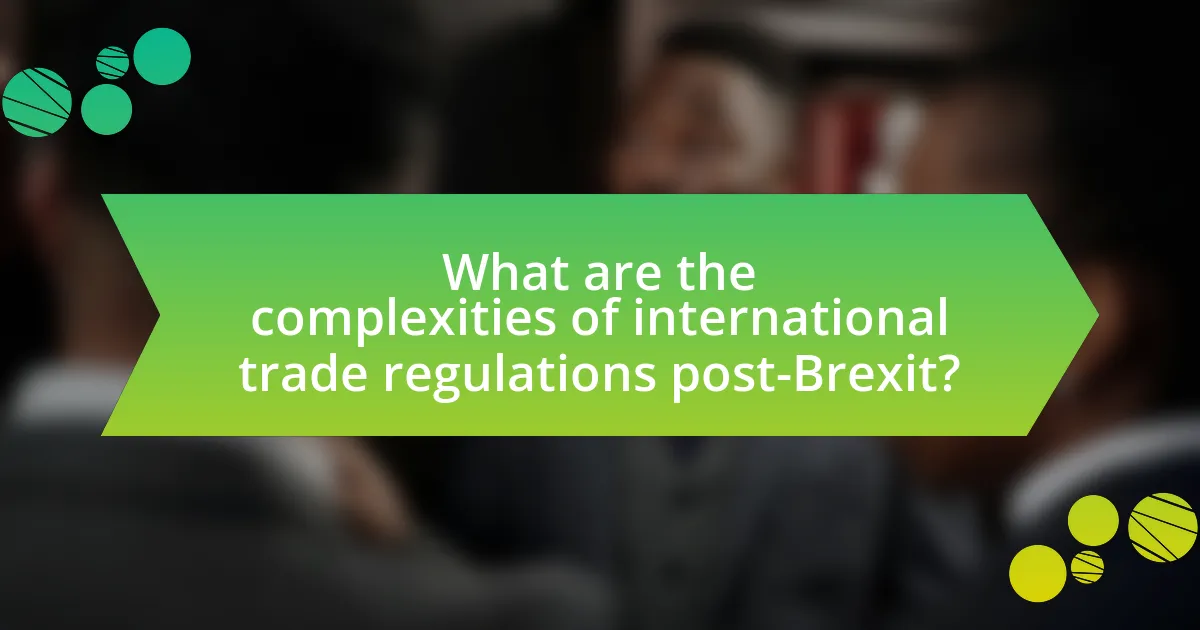
What are the complexities of international trade regulations post-Brexit?
The complexities of international trade regulations post-Brexit include the introduction of new customs checks, changes in tariff schedules, and the need for compliance with both UK and EU regulations. Following Brexit, the UK is no longer part of the EU Single Market, which has resulted in increased administrative burdens for businesses engaged in cross-border trade. For instance, customs declarations are now mandatory for goods moving between the UK and EU, leading to delays and additional costs. Furthermore, the UK has established its own trade agreements, which may differ from those previously negotiated by the EU, complicating the landscape for exporters and importers. The Trade and Cooperation Agreement (TCA) between the UK and EU, effective from January 1, 2021, outlines specific rules of origin requirements that businesses must navigate to benefit from tariff-free trade. These complexities necessitate a thorough understanding of evolving regulations and compliance requirements to avoid penalties and ensure smooth trade operations.
How has Brexit changed the landscape of international trade regulations?
Brexit has fundamentally altered the landscape of international trade regulations by removing the United Kingdom from the European Union’s single market and customs union. This separation has led to the establishment of new trade agreements and regulatory frameworks that differ from those previously governed by EU laws. For instance, the UK has negotiated bilateral trade deals with countries like Australia and Japan, which include specific tariff reductions and regulatory standards that are distinct from EU agreements. Additionally, the introduction of customs checks and regulatory barriers between the UK and EU has increased compliance costs and complexities for businesses engaged in cross-border trade. These changes necessitate a reevaluation of supply chains and trade strategies for companies operating in or with the UK, as they must now navigate a more fragmented regulatory environment.
What specific regulations have been affected by Brexit?
Brexit has significantly affected several specific regulations, including customs regulations, trade tariffs, and immigration laws. The transition from EU regulations to UK-specific rules has led to the introduction of new customs checks and documentation requirements for goods moving between the UK and EU, resulting in increased delays and costs for businesses. Additionally, the end of the free movement of people has altered immigration regulations, impacting the ability of EU nationals to work in the UK. These changes are evidenced by the implementation of the UK Global Tariff, which replaced the EU’s Common External Tariff, and the introduction of the new points-based immigration system in January 2021.
How do these changes impact trade agreements with the EU?
Changes in international trade regulations post-Brexit significantly impact trade agreements with the EU by introducing new tariffs and customs checks. These alterations have led to increased costs and delays for businesses engaged in cross-border trade, as evidenced by a 2021 report from the UK’s Office for National Statistics, which noted a 40% decline in exports to the EU in the first quarter following Brexit. Additionally, the introduction of non-tariff barriers has complicated compliance for companies, further straining trade relations.
Why is it important to understand these complexities?
Understanding the complexities of international trade regulations post-Brexit is crucial for businesses to ensure compliance and avoid legal penalties. The shift in trade agreements and tariffs can significantly impact supply chains, pricing strategies, and market access. For instance, the UK’s departure from the EU has led to new customs procedures and regulatory standards that businesses must navigate to maintain competitiveness. Failure to grasp these complexities can result in increased costs, delays, and loss of market opportunities, as evidenced by the 2021 report from the UK Chamber of Commerce, which highlighted that 40% of businesses faced disruptions due to unfamiliar regulations.
What risks do businesses face without proper knowledge of regulations?
Businesses face significant risks without proper knowledge of regulations, including legal penalties, financial losses, and reputational damage. Legal penalties can arise from non-compliance with trade regulations, which may result in fines or sanctions imposed by regulatory bodies. Financial losses can occur due to unexpected tariffs or trade barriers that businesses may not anticipate without understanding the regulatory landscape. Reputational damage can stem from public scrutiny or loss of customer trust if a business is found to be violating regulations. For instance, a study by the World Bank indicates that businesses lacking regulatory knowledge are 30% more likely to face compliance issues, leading to increased operational costs and potential market exit.
How can understanding these complexities benefit businesses?
Understanding the complexities of international trade regulations post-Brexit can significantly benefit businesses by enabling them to navigate legal requirements effectively, thereby reducing compliance risks. Businesses that grasp these complexities can optimize their supply chains, ensuring timely delivery and cost efficiency, which is crucial in a competitive market. For instance, a study by the Institute of Export and International Trade found that companies well-versed in trade regulations experienced a 20% reduction in delays and penalties, enhancing their operational efficiency. This knowledge also allows businesses to identify new market opportunities and adapt their strategies accordingly, ultimately leading to increased profitability and market share.
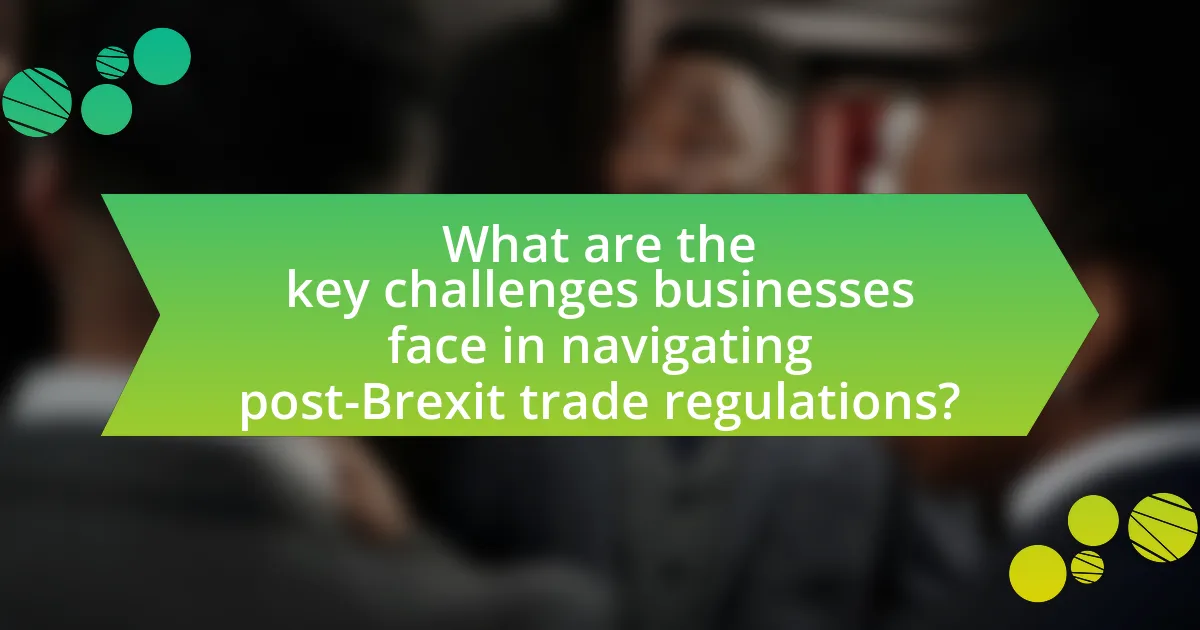
What are the key challenges businesses face in navigating post-Brexit trade regulations?
Businesses face several key challenges in navigating post-Brexit trade regulations, primarily including increased customs checks, regulatory divergence, and supply chain disruptions. Increased customs checks have led to longer wait times and higher costs for imports and exports, as businesses must now comply with new documentation requirements and tariffs. Regulatory divergence between the UK and EU has created complexities in compliance, as businesses must adapt to differing standards and regulations, which can lead to increased operational costs and legal uncertainties. Additionally, supply chain disruptions have arisen due to changes in trade routes and logistics, impacting inventory management and delivery timelines. These challenges are compounded by the need for businesses to invest in training and technology to manage the new regulatory landscape effectively.
How do tariffs and customs duties affect international trade?
Tariffs and customs duties significantly impact international trade by increasing the cost of imported goods, which can lead to reduced trade volumes. When a country imposes tariffs, it raises the price of foreign products, making them less competitive compared to domestic goods. For instance, the World Trade Organization reported that tariffs can lead to a decrease in trade by 10% to 20%, depending on the sector. This reduction in trade can result in limited market access for exporters and higher prices for consumers, ultimately affecting economic growth and trade relationships between countries.
What are the new tariff rates for goods traded with the EU?
The new tariff rates for goods traded with the EU vary depending on the product category, with many goods facing zero tariffs under the EU-UK Trade and Cooperation Agreement. However, specific tariffs apply to certain sectors, such as agriculture and automotive, where rates can range from 0% to 10%. For example, tariffs on beef can reach 12.8%, while tariffs on cars can be as high as 10%. These rates are established to regulate trade and protect domestic industries post-Brexit.
How can businesses effectively manage customs compliance?
Businesses can effectively manage customs compliance by implementing a robust compliance program that includes thorough training, accurate documentation, and regular audits. A well-structured compliance program ensures that employees understand customs regulations and procedures, which is critical given the complexities introduced by changes in international trade regulations post-Brexit. Accurate documentation, including invoices, packing lists, and customs declarations, is essential to avoid delays and penalties, as customs authorities increasingly scrutinize shipments. Regular audits help identify compliance gaps and ensure adherence to evolving regulations, thereby minimizing the risk of non-compliance. According to a report by the World Customs Organization, businesses that invest in compliance training and technology can reduce customs-related delays by up to 30%.
What role do non-tariff barriers play in post-Brexit trade?
Non-tariff barriers significantly impact post-Brexit trade by introducing regulatory obstacles that can hinder the flow of goods and services between the UK and the EU. These barriers include customs checks, product standards, and regulatory compliance requirements that have increased since the UK left the EU single market. For instance, the introduction of customs declarations and health checks has led to delays and increased costs for businesses, as evidenced by reports indicating that UK exports to the EU fell by 40% in January 2021 due to these new trade barriers. Consequently, non-tariff barriers complicate trade relationships and require businesses to adapt to new regulatory frameworks, affecting overall trade volumes and economic performance.
What are the most common non-tariff barriers encountered?
The most common non-tariff barriers encountered include import quotas, licensing requirements, and technical standards. Import quotas restrict the quantity of goods that can be imported, thereby limiting market access. Licensing requirements necessitate that importers obtain specific permissions, which can delay the entry of goods into a market. Technical standards, such as safety and quality regulations, can create obstacles if they differ significantly from those in the exporting country. These barriers can significantly impact trade flows and market dynamics, as evidenced by the increased compliance costs and delays reported by businesses navigating post-Brexit trade regulations.
How can businesses overcome these non-tariff barriers?
Businesses can overcome non-tariff barriers by implementing comprehensive compliance strategies that align with international trade regulations. These strategies include conducting thorough market research to understand specific regulatory requirements in target markets, engaging with local legal experts to navigate complex regulations, and investing in training for staff to ensure adherence to compliance standards. For instance, a study by the World Trade Organization indicates that businesses that actively engage in compliance training experience a 30% reduction in trade-related delays, demonstrating the effectiveness of proactive measures in overcoming non-tariff barriers.
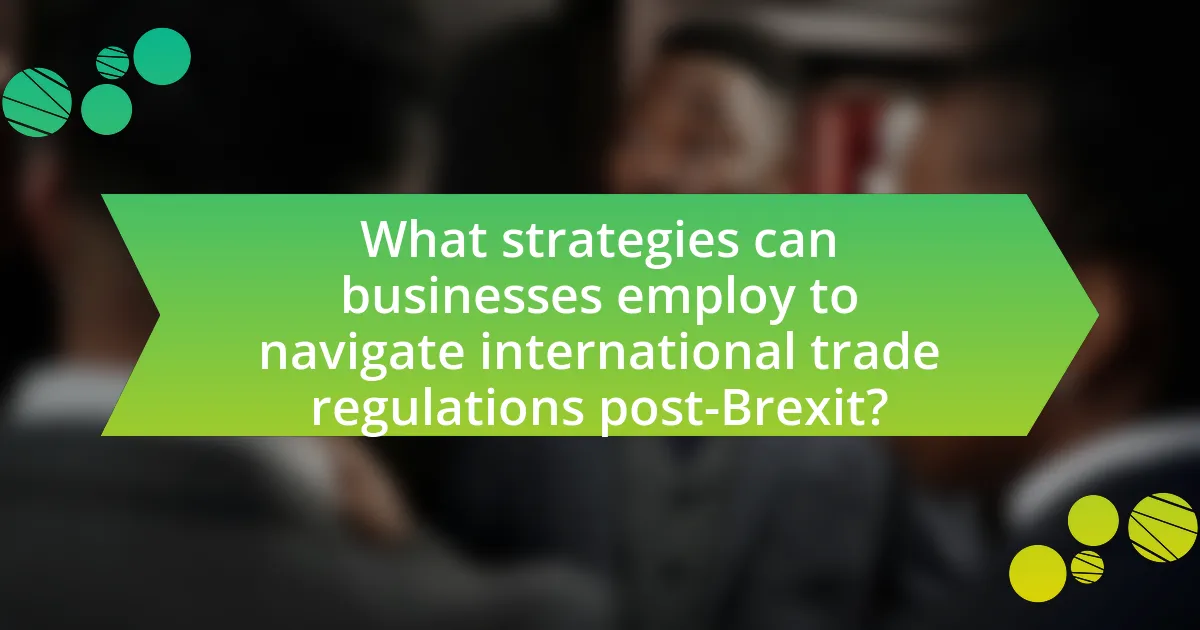
What strategies can businesses employ to navigate international trade regulations post-Brexit?
Businesses can employ several strategies to navigate international trade regulations post-Brexit, including establishing a comprehensive understanding of new customs procedures, leveraging technology for compliance, and engaging with trade experts. A thorough understanding of the new customs procedures is essential, as the UK has left the EU customs union, resulting in changes to tariffs and documentation requirements. Utilizing technology, such as automated compliance software, can streamline the process of adhering to regulations and reduce errors. Additionally, consulting with trade experts or legal advisors can provide insights into the evolving regulatory landscape, ensuring that businesses remain compliant with both UK and EU regulations. These strategies are crucial for minimizing disruptions and maintaining smooth operations in international trade.
How can businesses stay informed about regulatory changes?
Businesses can stay informed about regulatory changes by subscribing to industry newsletters, attending relevant webinars, and engaging with professional associations. These methods provide timely updates on new regulations and compliance requirements. For instance, organizations like the International Chamber of Commerce and local trade bodies often disseminate critical information regarding changes in trade regulations. Additionally, utilizing regulatory technology platforms can help businesses track changes in real-time, ensuring they remain compliant with evolving laws.
What resources are available for tracking trade regulations?
Resources available for tracking trade regulations include government websites, trade associations, and specialized databases. Government websites, such as the UK Government’s official site and the European Commission’s Trade page, provide up-to-date information on regulations and compliance requirements. Trade associations, like the British Chambers of Commerce, offer insights and updates relevant to specific industries. Additionally, databases such as the World Trade Organization’s Trade Policy Review Mechanism and the Global Trade Alert provide comprehensive data and analysis on trade regulations and their impacts. These resources are essential for businesses navigating the complexities of international trade regulations, especially in the context of changes following Brexit.
How can businesses leverage trade associations for support?
Businesses can leverage trade associations for support by accessing industry-specific resources, networking opportunities, and advocacy efforts. Trade associations provide members with valuable information on regulatory changes, best practices, and market trends, which is crucial for navigating complexities in international trade regulations, especially post-Brexit. For instance, the British Chambers of Commerce reported that 70% of businesses found membership beneficial for understanding new trade rules and compliance requirements. Additionally, trade associations often engage in lobbying efforts to influence policy decisions that affect their industries, thereby amplifying the voice of individual businesses in regulatory discussions.
What best practices should businesses adopt for compliance?
Businesses should adopt a proactive compliance strategy that includes regular training, thorough documentation, and continuous monitoring of regulatory changes. Regular training ensures that employees are informed about the latest compliance requirements, which is crucial in the dynamic landscape of international trade regulations post-Brexit. Thorough documentation of processes and transactions provides a clear audit trail, which is essential for demonstrating compliance during inspections or audits. Continuous monitoring of regulatory changes allows businesses to adapt swiftly to new laws and guidelines, minimizing the risk of non-compliance. According to a report by the Institute of Export and International Trade, businesses that implement these best practices are 30% more likely to avoid compliance-related penalties.
How can businesses develop an effective compliance strategy?
Businesses can develop an effective compliance strategy by conducting a thorough risk assessment to identify regulatory requirements specific to their industry and operational regions. This involves analyzing applicable laws, such as the UK’s Trade and Cooperation Agreement with the EU, and understanding how these regulations impact trade practices. Furthermore, implementing robust training programs for employees ensures that all staff are aware of compliance obligations and best practices. Regular audits and monitoring mechanisms should be established to evaluate adherence to compliance standards, allowing businesses to adapt to any changes in regulations swiftly. According to a report by the Institute of Compliance, organizations that actively engage in compliance training and audits reduce the risk of regulatory breaches by up to 30%.
What common mistakes should businesses avoid in compliance efforts?
Businesses should avoid the mistake of underestimating the importance of thorough compliance training for employees. Inadequate training can lead to misunderstandings of regulations, resulting in non-compliance and potential legal penalties. Additionally, failing to stay updated on changing regulations can cause businesses to operate under outdated compliance frameworks, which is particularly critical in the context of international trade regulations that have evolved post-Brexit. According to a report by the Institute of Export and International Trade, 60% of businesses reported difficulties in adapting to new customs regulations, highlighting the necessity for continuous education and adaptation in compliance efforts.
What practical tips can businesses implement to navigate these complexities effectively?
Businesses can implement several practical tips to navigate the complexities of international trade regulations post-Brexit effectively. First, they should invest in comprehensive training for staff on new customs procedures and regulations, as understanding these changes is crucial for compliance. According to the UK Government’s guidance, businesses must familiarize themselves with the new customs declarations and tariffs that apply to goods moving between the UK and the EU.
Second, companies should utilize technology solutions, such as customs management software, to streamline the documentation process and ensure accuracy in submissions. Research from the Institute of Export and International Trade indicates that businesses leveraging technology can reduce errors and improve efficiency in handling customs paperwork.
Third, establishing strong relationships with customs brokers and freight forwarders can provide businesses with expert guidance and support in navigating the complexities of international trade. The British Chambers of Commerce highlights that collaboration with experienced partners can mitigate risks associated with compliance and logistics.
Lastly, businesses should regularly review and update their supply chain strategies to adapt to changing regulations and market conditions. The World Trade Organization emphasizes that proactive supply chain management is essential for maintaining competitiveness in a post-Brexit environment.
